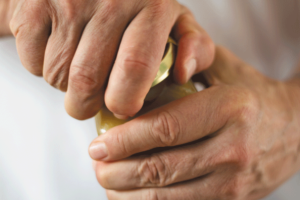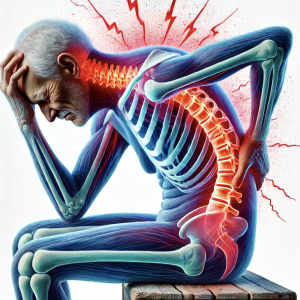Rehabilitation

Hand Grip Strength – The Vitality Meter
An Important Biomarker of Disease and Ageing
Handgrip strength (HGS) is a simple and reliable measurement of maximum voluntary muscle strength. It is one of the important tests we run during your care.
HGS can predict not only muscle mass and physical activity, but also the incidence of chronic diseases, nutritional status, quality of life, independence of daily life, length of hospital stay, and even mortality.
So we gain an important insight into your health, wellbeing, longevity, spinal and neurological function with this simple test.

Training and Rehabilitation
You need to be a patient of the practice and logged in to your account, to see this resource.

Adult Spinal Deformity
The Silent Menace
Adult Spinal Deformity Outweighs Other Chronic Conditions in Health Drama
When you think of health-related quality of life (HRQL) concerns, chronic conditions like arthritis, lung disease, diabetes, and congestive heart failure probably top your list.
But hold onto your lumbar support because Adult Spinal Deformity is here to steal the spotlight. We reveal how Adult Spinal Deformity is not just a Spinal issue – it is a Life issue.

Addition of a Sagittal Cervical Posture Corrective Orthotic Device to a Multimodal Rehabilitation Program Improves Short- and Long-Term Outcomes in Patients with Discogenic Cervical Radiculopathy
PUBLISHED: Arch Phys Med Rehabil. 2016 Dec;97(12):2034-2044. doi: 10.1016/j.apmr.2016.07.022. Epub 2016 Aug 27. Pub Med: https://www.ncbi.nlm.nih.gov/pubmed/27576192
AUTHORS: Moustafa IM, Diab AA, Taha S, Harrison DE.
CONCLUSIONS: The addition of the Denneroll cervical orthotic device to a multimodal program positively affected discogenic CR outcomes at long-term follow-up.
We speculate that improved cervical lordosis and reduced AHT contributed to our findings.

The efficacy of Cervical Lordosis rehabilitation for nerve root function, pain, and segmental motion in Cervical Spondylotic Radiculopathy
PUBLISHED: PhysioTherapy 2011; 97 Supplement: 846-847. https://www.researchgate.net/publication/258226733
AUTHORS: Moustafa IM, Diab AM, Ahmed A, Harrison DE.
CONCLUSIONS: Improved lordosis in the study group was associated with significant improvements in nerve root function, VAS rating, and translational and rotational motions of the lower cervical spine.
Only in the study group were the results maintained at long-term follow up.
IMPLICATIONS: Appropriate physical rehabilitation for Cervical Spondylotic Radiculopathy should include cervical sagittal curve correction, as it is may to lead greater and longer lasting improved function.

Demonstration of Central Conduction Time and Neuroplastic changes after Cervical Lordosis Rehabilitation in Asymptomatic Subjects
PRESENTED: Proceedings of the 14th biennial congress of the World Federation of Chiropractic, March 15-18, 2017. Pub Med: https://www.ncbi.nlm.nih.gov/pmc/articles/PMC5345783/
AUTHORS: Moustafa IM, Diab AAM, Taha S, Harrison DE.
CONCLUSION: Improvement of cervical spine alignment has an effect on central conduction time.

Prospective, Randomised, Double-Blind Clinical Study evaluating the correlation of Clinical Outcomes and Cervical Sagittal Alignment
PUBLISHED: Neurosurgery. 2011 May;68(5):1309-16; discussion 1316. doi: 10.1227/NEU.0b013e31820b51f3. PUB MED: https://www.ncbi.nlm.nih.gov/pubmed/21792113
AUTHORS: Villavicencio AT, Babuska JM, Ashton A, Busch E, Roeca C, Nelson EL, Mason A, Burneikiene S.
RESULTS: Patients who had maintained or improved segmental sagittal alignment, regardless of graft type, achieved a higher degree of improvement in Short Form-36 Physical Component Summary and Neck Disability Index scores. This was statistically significant (P < .038).
CONCLUSION: Maintaining a consistent segmental sagittal alignment or increasing segmental lordosis was related to a higher degree of improvement in clinical outcomes.
Spinal Centre Note: Appears surgeons are picking up what Chiropractic BioPhysics practitioners have been talking about. Well done.




